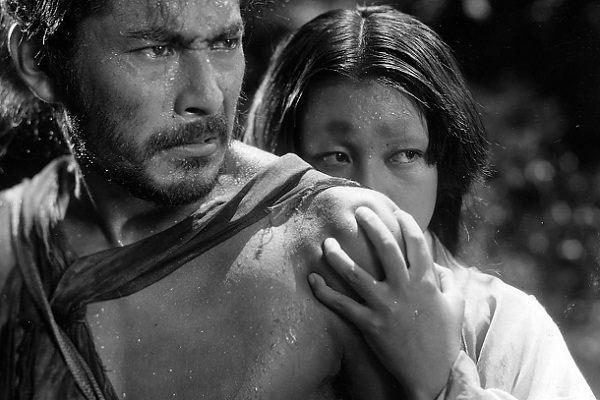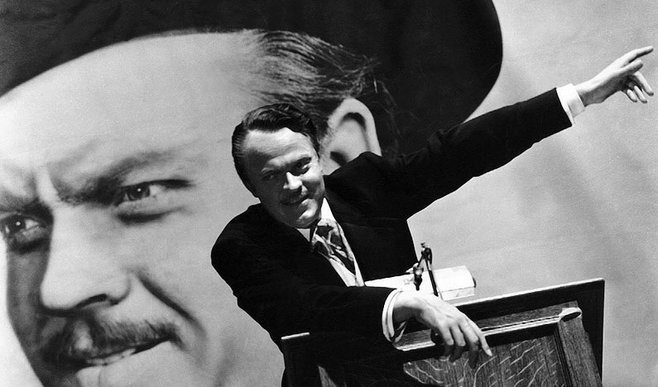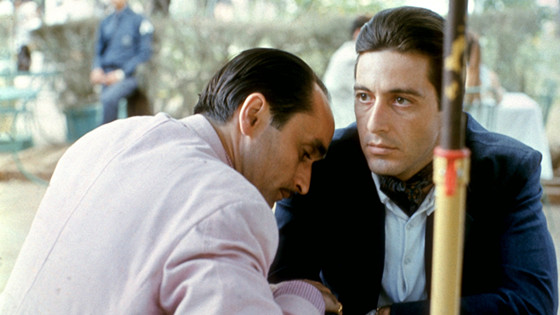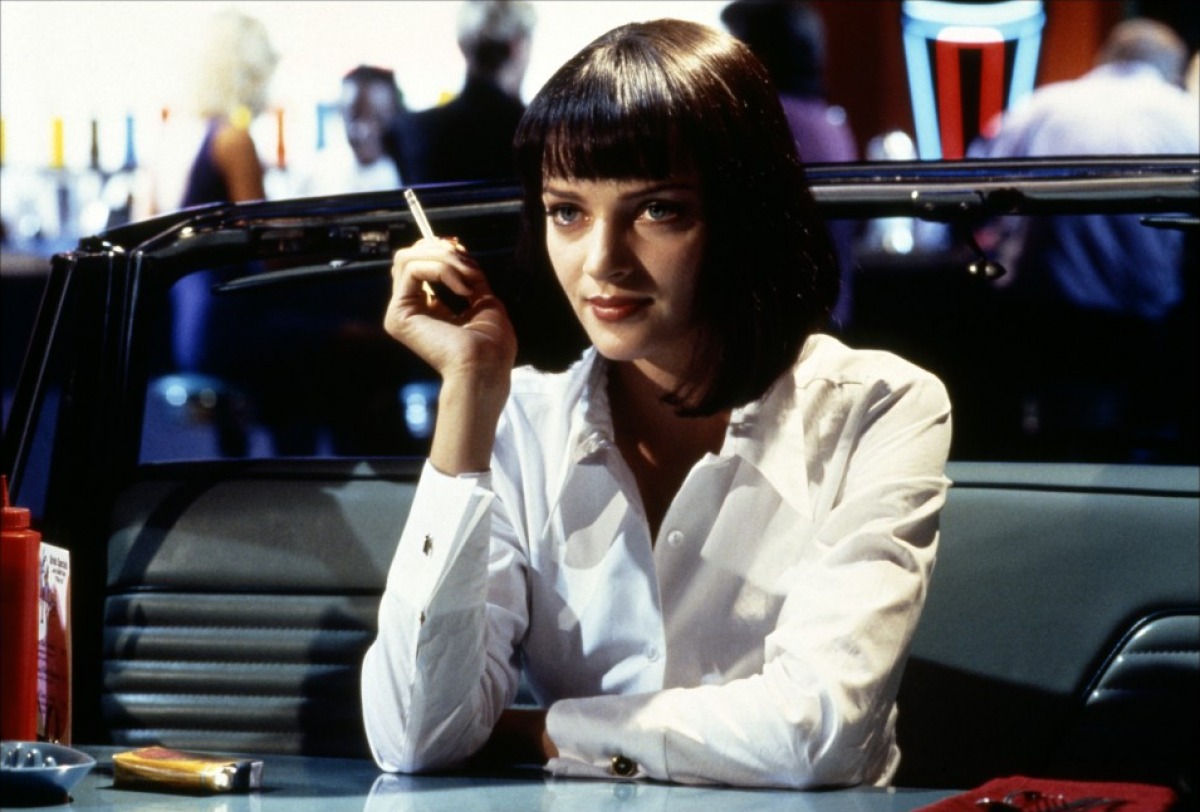5. Rashomon (1950)
Rashomon’s narrative was so inventive for the time (at least in film) that the structure has come to be known among film scholars as the “Rashomon effect”.
The film narrates the recount of the same event by four different people. The event, a heinous rape and murder, was witnessed by a bandit, a samurai, his wife, and a woodcutter. The thing is, as it often happens in court (the film’s frame is in a court, where each of them is called to testify), the versions of the story contradict each other. The same events were felt and interpreted differently be each person.
The films sets are mostly minimalistic and the cinematography beautiful; the film’s center of focus is always the characters and their recollections of the crime.
Rashomon is considered one of Akira Kurosawa’s best films. Even though it was received lukewarmly originally in Japan, in the west it was acclaimed and won the Honorary Academy Award for best Foreign Language film (back then there wasn’t a competitive award, just one film was chosen and there wasn’t always a winner).
Also Watch: A similar modern film could be “Hero”. Or a completely different film with a similar structure is Doug Liman’s “Go”.
4. Citizen Kane (1941)
You have heard enough of this one. The film changed film, the film that changed how films are made, and written, and thought of. The lighting, the angles, the story. But perhaps Citizen Kane’s greatest virtue is its narrative structure.
Citizen Kane tells the story of Charles Foster Kane, a newspaper tycoon born into poverty, and sent a way to get educated when his family is hit with a stroke of luck, with a gold mine appearing in they’re land. Once he gains control of his fortunes he starts a newspaper, and slowly takes control of the whole business.
The story of Kane is told not by an omniscient narrator, or by Kane himself, but by a series of people that are interviewed by a journalist trying to get a portrait of the man and the legend just after his passing; he’s trying to understand the meaning of Kane’s last words.
Different parts of Kane’s life are told by the people that knew him, and each tells from his own perspective. Even though when the film shows Kane the perspective doesn’t seem to change much, it’s with the remarks of the characters when talking to the interviewer that we really see how each saw Kane. We get to know the part of Kane that each of them knew.
A film history lesson, Citizen Kane is a masterpiece no matter which way you see it.
Also Watch: Mishima: A Life in Four Chapters
3. The Godfather: Part II (1974)
In essence, it’s hard to describe The Godfather – Part II as a fragmented film, it may be just a film that follows two storylines. But I ended up deciding to include it here, because it is a film that employs valiantly and to great effect the idea of two integrated narrative structures.
The Godfather – Part II, follows the story of Michael Corleone after he finally becomes the leader of the biggest mafia empire in America, following the events of the first film. But it also follows the story of his father, Vito Corleone, and how he started to become the man who built the empire Michael now controls.
The narrative of Vito serves as a comparative point to Michael’s story. We are seeing how Vito got where he ended up, how he treated his family, and the values behind his actions. As a counterpart, we see how Michael behaves with his power, how he treats his family. The thematic opposition we see as both narratives advance is remarkable, and a great example of a narrative that could be considered mildly fragmented.
Also Watch: Once Upon a Time in America
2. Pulp Fiction (1994)
The quintessential film from the 90s, the film that gave rise to a new generation of filmmakers, of snappy pop-culture obsessed dialogues, a perfect fit for the environment in the new millennium, Pulp Fiction was a trend-setter.
One of the sometimes less identified trends that Pulp Fiction set in motion (even though it obviously wasn’t the first to do it) was the idea of several narrative that, even though independent, correlate, share characters, and are told asynchronously.
In Pulp Fiction we follow primarily Vincent Vega and Jules Winnfield, two men that work for a gangster named Marsellus Wallace. What could’ve been a simple attempt at a neo-noir with pulp-ish elements, turns into much more as the narrative structure unwinds. There are three main stories, correlated, that are superimposed in the film, with each playing in order, but not in accordance to the others.
The asynchronous presentation of the plot, while at the same time following a relatively simple storyline, allows for further development of the characters, showing their pasts and futures, adding more weight to their actions in several cases.
Also Watch: “Amores Perros” or “Dias de Gracia”, both great Mexican films that tell fragmented stories involving crime, not always told in the correct order.
1. Memento (2000)
When “Memento” was released, in the year 2000, nobody was really sure what the writer and director, Christopher Nolan, would be doing a decade later. But everyone could agree on something: if this film wasn’t just a stroke of luck, that guy had a bright future ahead of him. Today, Christopher Nolan is one of the most popular (and consistently acclaimed by the critics) filmmakers alive. But when memento came out, he was just another indie filmmaker trying to make it big in his sophomore feature. What was so special about Memento?
Memento tells the story of a man called Leonard, who has short-term memory loss. All he remembers from recent times is that somebody killed his wife, and he is on the hunt for the man who did it. His way to remember new clues is to tattoo them on his body (along with making notes and other more obvious things). The film is shown backwards, each scene (that individually play forwards, otherwise the sound would be really weird) is chronologically before the preceding scene.
The narrative structure contributes to the film maintaining most of its mysteries until the end, and it slowly reveals and twists and turns the truth and the plot. Memento is a truly brilliant film from a brilliant filmmaker, who has managed to stay true to his roots and his craft in spite of being one of the most successful directors in Hollywood.
Also Watch: For a more visceral and traumatizing approach to this type of narrative structure, you can watch “Irreversible”, from French ‘enfant terrible’ Gaspar Noe.
Author Bio: Hector Gonzalez was born in Monterrey (with two ‘r’s), México, and one fateful afternoon he went to see Lord of the Rings: Return of the King to the theaters when he was 8 years old. He fell in love with cinema, and even though he usually gets films a few weeks late to be completely bias free (especially Oscar front runners) and his local cinemas don’t show that much arthouse, he still thinks that going to the theater and seeing a good movie is the most magical experience there is.




